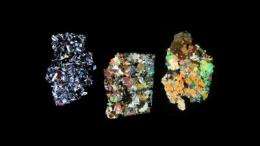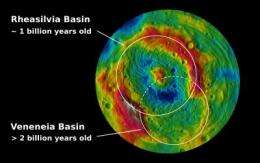Asteroid collision that spawned Vesta's asteroid family occurred more recently than thought

A team of researchers led by a NASA Lunar Science Institute (NLSI) member based at Southwest Research Institute has discovered evidence that the giant impact crater Rheasilvia on Asteroid (4) Vesta was created in a collision that occurred only about 1 billion years ago, much more recently than previously thought. This result is based on the analysis of high-resolution images obtained with the Dawn spacecraft, which entered orbit around Vesta in July 2011.
In addition to creating the crater, the impact is believed to have launched a large number of fragments into space, some of which later escaped the main belt and possibly hit the Earth.
Vesta, the second-most massive body in the main asteroid belt, is believed to have formed within the first few million years after the earliest solar system solids (~4.6 billion years ago). According to models, its early evolution occurred in an environment where collisions with other asteroids were much more frequent than they are today. It was thought that one such early collision on Vesta created a swarm of fragments, which we now call an asteroid family. Although Vesta and its family are located between Mars and Jupiter, smaller pieces of these asteroids can be found in meteorite collections on Earth, including most eucrite, howardite and diogenite meteorites.

Several large craters on Vesta were first inferred by Hubble Space Telescope imaging. However, a photographic survey by the Dawn spacecraft revealed a collision-dominated history, as well as a strong north-south dichotomy in the asteroid's cratering record. Vesta's heavily cratered northern terrains retain much of their earliest history, but the southern hemisphere was reset by two major collisions in more recent times.
The Dawn survey revealed high-resolution details of these craters, allowing scientists to estimate their ages on the basis of the number of younger craters that have been superposed on the crater's floor since their formation.
Rheasilvia, the youngest of these impact structures, is about 505 kilometers (314 miles) across. The number of smaller craters found within Rheasilvia can be used like a clock to estimate its formation age. The best estimates suggest it is only about 1 billion years old. For reference, this is nearly 3 billion years after the barrage of comets and asteroids that produced the so-called Late Heavy Bombardment of the Moon (and Solar System). Before this time, the asteroid belt is believed to have been substantially larger than it is today.
The volume of material excavated by the impact that formed Rheasilvia is larger than the estimated volume of known asteroidal members of Vesta's dynamical family, suggesting that most of the observed family was formed in this single event.
"An age of about 1 billion years for Rheasilvia is unexpectedly young. This result has important implications for our understanding of the evolution of the Vesta, its asteroid family and the inner main asteroid belt in general. We have just started exploring Vesta's secrets, and I'm sure other intriguing results will come along shortly," said NLSI team member Dr. Simone Marchi, lead author of "The Violent Collisional History of Asteroid (4) Vesta," published in the May 11 issue of the journal Science.
Provided by Southwest Research Institute





















